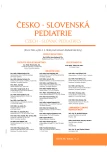Toy – the safe subject on the children‘s departments?
Authors:
J. Zelenková
Authors‘ workplace:
Hygienická stanice hlavního města Prahy
Published in:
Čes-slov Pediat 2020; 75 (2): 71-76.
Category:
Original Papers
Overview
Staphylococci are ubiquitous microorganisms commonly found in daily use articles. Only some of the 40 species and subspecies are used in human medicine. The most important for humans are Staphylococcus aureus, S. epidermidis and S. saprophyticus.
Information on the presence of staphylococci on children's toys in hospitalized children is not available on routine basis. Foreign studies conducted abroad suggest that the toys could be sources of healthcare-associated infections. Consequently a survey was carried out in Prague hospitals in 2016 and 2017. The results of the study show that capture of staphylococci on toys is influenced, in particular, by the material from which the toys are produced and also by the environment.
Keywords:
staphylococci – multiresistant – toys – surface
Sources
1. Antimicrobial resistance in zoonotic bacteria still high in humans, animals and food, say ECDC and EFSA. Dostupné z https://ecdc.europa.eu/en//news-events/antimicrobial-resistance-zoonotic-bacteria-still-high-humans-animals-and-food-say-ecdc [online].
2. The European Union summary report on antimicrobial resistance in zoonotic and indicator bacteria from humans, animals and food in 2016. Dostupné z https://efsa.onlinelibrary.wiley.com/doi/10.2903/j.efsa.2018.5182 [online].
3. Bednář M. Lékařská mikrobiologie: bakteriologie virologie parazitologie. 2. vyd. Praha: Marvil, 1996 : 193–204.
4. Hobstová J. Stafylokové infekce. In: Beneš L. Infekční lékařství. Praha: Galén, 2009 : 197–201.
5. Humphreys H. Staphylococcus. In: Greenwood D. Medical Microbiology: A Guide to Microbial Infections: Pathogenesis, Immunity, Laboratory Diagnosis and Control. 19th ed. Elsevier, 2018 : 134–141. ISBN 978--0702072000.
6. Stolf Boretti V, Nunes Corrêa R, Soléo Ferreira dos Santos S. Sensitivity profile of Staphylococcus spp. and Streptococcus spp. Rev Paul Pediatr 2014; 32 (3): 151−156.
7. Summary of the latest data on antibiotic consumption in EU: 2016. Dostupné z https://www.ecdc.europa.eu/en/publications-data/summary-latest-data-antibiotic-consumption-eu-2016 [online]. [cit. 2018-03-14].
8. Davies M, Mehr S, Garland S, Morley CJ. Bacterial colonization of toys in neonatal intensive care cots. Pediatrics 2000; 2 : 1−5.
9. Merriman E, Corwin P, Ikram R. Toys are a potential source of cross-infection in general practitioners’ waiting rooms. Br J Gen Pract 2002; 52 : 138−140.
10. Avila-Aguero ML, German G, Paris MM, Herrera JF. Safe Toys Study Group. Toys in a pediatric hospital: are they a bacterial source? Am J Infect Control 2004; 32 : 287−290.
11. Ramos SR. Toys from hospital playrooms as a source of pathogens in nosocomial infections. Rev Paul Pediatr 2014; 32 (3): 149−150.
Labels
Neonatology Paediatrics General practitioner for children and adolescentsArticle was published in
Czech-Slovak Pediatrics

2020 Issue 2
Most read in this issue
- Foreign bodies in the swallowing pathways in children
- Successful ultrasound-guided percutaneous ethanol injection therapy of thyroid cysts in adolescents
- Treatment of thrombosis in newborns and infants
- Aspiration of the foreign bodies in children – case reports
